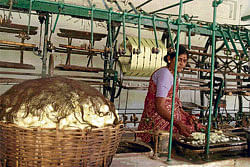
Of the total 80,000 hectares under mulberry cultivation in the State, half of them are in Kolar and Shidlaghatta taluks.
But the government’s move to import duty-free silk from China has jolted the industry and the families depending on the silk industry.
The government’s argument is that only 19,000 metric tonnes of silk is produced in the country while the demand for the silk is 26,000 metric tonnes.
But importing silk from neighbouring China will impact sericulturists here drastically, says farmers’ leader Mallur Shivanna.
Speaking with Deccan Herald, he says that the raw silk produced here has a unique texture, thanks to the soil and water of the taluk.
The silk industry spread over 3,000 villages in both the districts has more than 50,000 families depending on it. The total annual business produced by both districts is Rs 3,864 crore, he said.
“Since the price of silk produced in India and China is the same, the decision to import the silk would leave the sericulturists here in the lurch. Farmers are worried,” he said. So what is the reason for the government’s move?
“Silk traders are behind the government’s decision to import silk,” he says.
Water table depleting
Despite the depleting groundwater level in the district, sericulturists struggle to supply the best silk to the market. Even the silk weavers work in an impoverished condition, he urged.
He wants the government to check smuggling of silk from Bangladesh and Nepal. He demanded that the government allow 50 per cent duty on silk from China to help the local silk industry.